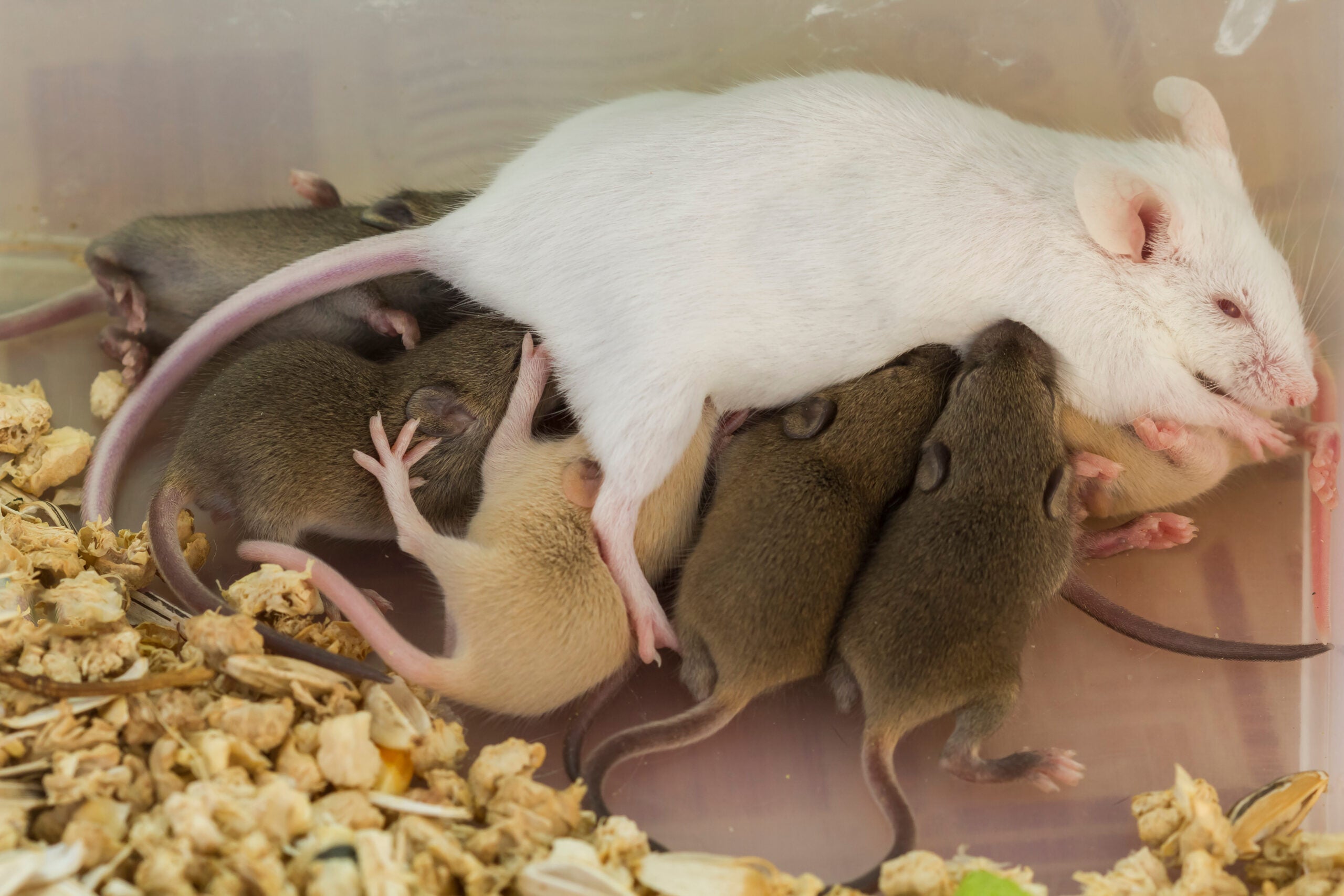Could these chemicals make my grandchild look fat?
Richard Denison, Ph.D., is a Senior Scientist.
In an earlier post by my colleague Dr. Jennifer McPartland, she described new research that is linking certain chemical exposures to the rising epidemic of diabetes and obesity. Some of that research, mainly conducted in laboratory animals, is revealing that when a mother is exposed to such chemicals before or during pregnancy, her offspring are more likely to suffer from diabetes and obesity as they mature.
How might such a proclivity toward development of diabetes and obesity later in life be transferred from one generation to the next, from mother to child?
In a word, epigenetics.
The prefix “epi-“ comes from the Greek, and means “on top of.” So what tops genetics? Isn’t it at the root of all things biological?
Epigenetics is a huge and rapidly expanding area of biological research and discovery. The journal Science, devoted an entire special section to it last October. I won’t even try to do it justice here. But here’s the basic concept. Each of the cells in each of our bodies has the exact same DNA, the identical sequence, in our chromosomes. Yet as we develop from a fertilized egg to countless billions of cells, those cells – all with the identical DNA –turn into more than 200, radically different types of cells with very distinct functions.
How epigenetics works
A key mechanism by which this miracle happens, it turns out, is through modifications to the structure of our DNA. These modifications to DNA are not changes to its inviolable sequence of nucleotide pairs, known as mutations; rather, the expression of genes and other DNA functions can be altered by “marking” the DNA. Such “marks” may be added in any of several different ways. For example, there are specialized enzymes that add methyl groups to DNA – a process called “methylation” – so as to alter the timing or extent of expression of a gene. Similarly, the binding of proteins called histones to the DNA in specific ways is thought to be another epigenetic mechanism.
Such changes in one cell can then be propagated to other cells through plain old cell division as the organism grows. So, for example, we know certain genes are turned on or off that cause a cell to differentiate into a bone cell or fat cell. When that cell divides, it produces more bone or fat cells.
But here’s the real kicker: Epigenetic changes, like mutations, are heritable – that is, they can be passed from one generation to the next.
Think about that: Some factor affects the environment in which a cell’s DNA exists, and that factor can change, not the DNA sequence itself, but the behavior of that DNA, and that change can affect in turn not only the person or other organism in which it first happens but in their offspring too. Research indicates epigenetic changes can be relatively stable.
Epigenetic “evolution” has been well-documented in plants, fungi and invertebrates , and growing evidence from studies in laboratory animals suggests it can occur in mammals as well.
What about people?
Epigenetics is clearly at play in people; otherwise we wouldn’t develop — our cells with their identical DNA wouldn’t be able to differentiate. But showing that epigenetic changes can be transferred between generations in people is particularly challenging. That’s because we live a long time, so demonstrating transfer between generations is, shall we say, logistically difficult. We also are genetically diverse, much more so than a strain of mice used in a lab, so it’s difficult to rule out that any observed change is due to genetic rather than epigenetic changes. And, of course, we can’t run intentional experiments on people for ethical reasons.
Some of the first clues that epigenetics are at work in people came from a study in Sweden that relied on 200 years of records of grain harvests. The abundance, or lack thereof, of those harvests was found to correlate with the incidence of diabetes and heart disease in the descendants of those who ate well or went hungry. Bizarrely, the grandchildren of men who ate well in the years immediately preceding their entry into puberty had significantly shortened life spans compared to the grandchildren of men who had less access to food during those formative years. That’s due to a four-fold increase in the death rate resulting from diabetes (and some increase in cardiovascular disease) in the grandchildren of the well-fed ancestors.
Is that wild or what?
Now, some studies in laboratory animals have documented that the diet of mothers during pregnancy can alter not only the body characteristics of her offspring, but also the methylation pattern of genes in her offspring that are known to be involved in controlling metabolism. That kind of epigenetic effect of maternal diet is far more significant than most genetic changes – because it operates far faster, within a single generation.
To date, little analogous evidence has been available in people. Studies as far back as the 1970s found that women experiencing famine during pregnancy correlated with obesity in their offspring when they reached adulthood. A study of Dutch women who were pregnant while suffering starvation during World War II found that their children were more likely to be smaller, as well as to suffer from diabetes, obesity, cardiovascular disease and other health problems. And their children in turn were also smaller than average.
These fascinating studies don’t necessarily prove epigenetic changes are to blame for the observed effects.
However, a study by Godfrey et al. just published in the journal Diabetes starts to do just that. The researchers examined the methylation patterns of five metabolic control genes in cells drawn from the umbilical cord tissue of healthy babies. (The umbilical cord is composed almost entirely of cells of fetal, not maternal, origin.) They then looked for correlations between those methylation patterns and the nutritional status early in their pregnancies of the women who gave birth to those babies. Finally, they followed those babies until they reached the age of 9 years old.
Here’s what they found: The lower the mothers’ carbohydrate intake was during early pregnancy, the higher was the extent of methylation of certain of those metabolic control genes in their babies at birth – and the more likely their children were to be overweight at age 9.
These data strongly suggest a fetal developmental basis for later-life obesity.
This paper cites a body of evidence indicating that genetic factors explain only a part, likely a small part, of the risk of diabetes, obesity and heart disease, and that environmental factors – in this case, those in the prenatal environment – play a greater role.
The authors’ conclusion is a scientist-speak mouthful:
“Our study shows that specific components of the epigenetic state at birth predict later childhood adiposity. … The current study implicates the human prenatal environment with epigenetic changes in nonimprinted genes and is the first to link epigenetic status at birth with clinically relevant later phenotypic variation.”
Translation: Mom doesn’t eat enough during early months of pregnancy … key genes involved in metabolic control in her baby become more heavily methylated … and 9 years later, her child is more likely to be overweight.
So, what does all this have to do with chemicals not normally present in our bodies? My colleague’s earlier post started us down that path. Chemicals to which women are exposed before or during pregnancy can become part of the “environment” not only for them but for their fetuses. Certain of these chemicals are known to be “obesogens:” When pregnant mice are exposed to them, they disrupt normal biological activity in their fetuses in such a way that later “promotes fat accumulation and obesity” in their pups.
A likely mechanism? You guessed it, epigenetics. We’ll have more to say in these pages on this and related topics, so keep coming back.













One Comment
This is fascinating. I have read some on epigenetics, but they way you write and explain it is excellent. Especially for the regular guy like myself. Thank you! I guess I’m glad now that I pigged out and gained 40 pounds durning my pregnancies? :)